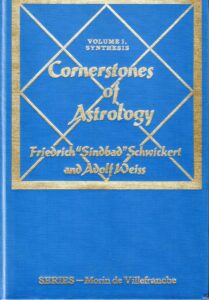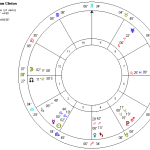Cornerstones of Astrology is an unusual book with a curious history that was inspired by the work of Jean-Baptiste Morin de Villefranche (1583-1656).
Morin’s magnum opus, Astrologia Gallica was published in Latin in 1661, five years after his death, and not many took notice. The book was rescued from obscurity by French astrologer Henri Selva (b. 1861), who translated its most important section (Book 21) on synthesizing the horoscope in 1897, and wrote a commentary a few years later, making turn of the century French readers aware of the depth of Morin’s thinking.
Viennese astrologers Friedrich “Sinbad” Schwickert (1837-1930 – a frigate captain) and Adolf Weiss, M.D. (1888-1956) digested Selva’s books and together wrote a 5-volume work, Bausteine der Astrologie (Leipzig 1925-1927) based on Morin’s techniques. Weiss later relocated to Argentina (a wise move since at least one of Sinbad’s other astrology students was killed by the Nazis), and published a Spanish version of the work in 1945.
Cornerstones of Astrology is a 1972 English translation by an unidentified astrologer based on the Schwickert and Weiss Spanish translation. It seems to me that it covers only the first two original German volumes, on the elements and synthesis (the latter once again following Morin’s crucial Book 21).
Quotes from Selva’s work are some of the most compelling parts of the text, along with those from Morin himself. The authors nevertheless state that Selva was “not very successful on his enterprise.” Were they more familiar with Morin’s original work? Only somewhat, it appears, as they admit it was written in “an almost incomprehensible Latin.” Nevertheless, Cornerstones effectively communicates Morin’s techniques and shows how charts can be judged using it.
The first half of the book describes the Primary Characteristics (hot, cold, wet, dry and fire, earth, air and water) and Essential Nature of the planets, signs and houses. These include lists with more modern esoteric discussions that reference Ptolemy and 19th to early 20th texts as sources, with much having little to do with traditional astrology. Uranus and Neptune are addressed, and Pluto mentioned but not included, due to a lack of research. I don’t feel the first part of the book works particularly well.
With the chapter on Cosmic State and Local Determination, we finally begin to get into Morin’s techniques. Cosmic State relates to each planet’s strength from its sign, malefic or benefic nature and aspects. Local (or Accidental) Determination or Terrestrial State takes a planet’s house placement and rulerships into consideration; in other words, where the planets fall, come from and lead to at a particular time and place. Do they have analogous meanings with the houses they’re in and planets they combine with? Do they facilitate or hinder the affairs of the houses they’re involved with, and how? All of these considerations will inform our judgment.
The book goes on to describe how the techniques work in example horoscopes. While at times the astrologers digress, their analysis is thorough and focused ( I sensed a Virgo approach and indeed, both were Virgo). Schwickert and Weiss communicate Morin’s ideas and show how the facets of the horoscope are inter-related in charts. I don’t know of another text that goes into such great depth of systematic analysis. (Patti Tobin Brittain’s Planetary Powers presents isolated elements of similar considerations without real chart examples.)
The criteria used range in importance from planetary position and essential dignity to house associations and rulerships, then finally aspects. General significators (the Moon for the mother, Saturn for the father) are too general, but may be helpful when they coincide with more specific determinations found in the birth chart (like Saturn in the 4th or the Sun ruling the 10th house).
The steps are challenging enough in themselves, but there are additional hurdles. Schwickert and Weiss use abbreviations: “M” represents malefics and “m” accidental malefics, for example, and houses are given in Roman numerals, both of which I found unwieldly. In addition, aspect symbols are used but sometimes the characters aren’t printed completely. (The authors share Saturn in detriment in the 7th house – perhaps creating a barrier to access?) There are typos in some of the charts (one has no date listed and there are other errors and omissions). The three charts from Morin don’t include the modern planets, while the others do, and most of the authors’ collection of charts give times to the second, with no indication of how they were rectified. The 1972 English translation is not the best overall, and has made no attempt to update original comments on sexuality and lifestyle, which some today may find objectionable.
Finally, Schwickert and Weiss only present the steps of their judgment that are necessary to see how the combinations of planets, houses and aspects work together. But all charts are in the appendix, so the reader must continually flip back and forth between charts and text, often with little reminder of who the people are. No charts are completely delineated in one place.
Despite its limitations, Cornerstones of Astrology is written by expert astrologers, covers an amazing amount of ground and provides worked examples of how Morin may have looked at horoscopes. As a result, this book is unique and valuable.
Check out my blog post on Morin and his Astrologia Gallica, which has additional links.
Buy Cornerstones of Astrology on Amazon.com.
(About my Amazon links.)

